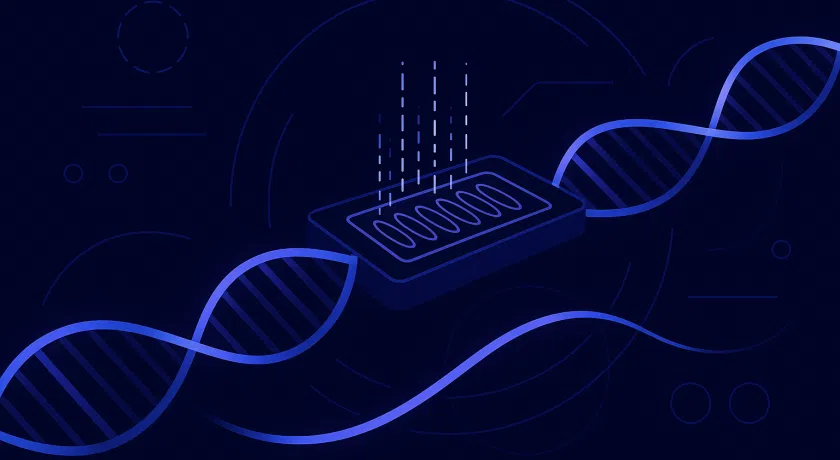
The 10x Genomics Single Cell Gene Expression Flex (10x Flex) kit for fixed RNA profiling expands sample access to include fresh, formaldehyde-fixed, and FFPE tissues for single-cell or single-nucleus RNA sequencing. How does it work? What are its capabilities, and what are its limitations?
As a scientist or pharmaceutical researcher, you constantly seek new technologies and methods to help you understand cellular and molecular mechanisms that drive disease pathogenesis or drug response.
Single-cell RNA sequencing (scRNA-seq) is a powerful tool that enables profiling the transcriptomes of individual cells, providing a view of gene expression in unprecedented detail.
However, traditional scRNA-seq methods require fresh, methanol-fixed, or cryopreserved cells and are unsuitable for formaldehyde-fixed or FFPE samples, limiting the types of samples that can be analyzed.
That’s where 10x Genomics’ Chromium Single Cell Gene Expression Flex solution comes in. This product was introduced by 10x Genomics in 2022, and Single Cell Discoveries now provides it as a service. It delivers sensitive whole-transcriptome profiling of formaldehyde-fixed and FFPE samples. This technology allows you to streamline your studies and expand sample access to include fresh, formaldehyde-fixed, and FFPE tissues.
In this blog, we detail how it works, what its benefits and limitations are, and how you can use it:
- Jump to: How Fixed RNA Profiling works
- Jump to: Benefits of Fixed RNA Profiling
- Jump to: Limitations of Fixed RNA Profiling
- Jump to: Product specifications
- Jump to: Summary figure

How Fixed RNA Profiling works
Step 1: Sample fixation and permeabilization
The Chromium Single Cell Gene Expression Flex Kit utilizes advanced chemistry to fix and permeabilize cells. It allows you to store samples at -80°C, ship them, and analyze them without compromising data quality (see Figure 2). We outline the sample fixation protocol in our user guide Sample Fixation for Single Cell Gene Expression Flex.

Step 2: Probe hybridization
Once the fixed single-cell or -nuclei samples are quenched in the lab, they are hybridized to probe sets. These RNA probe sets target predetermined regions in the transcriptome designated for high-quality scRNA-seq results. Currently, there’s a human and a mouse probe set.
- The human transcriptome probe set consists of 53,957 probes and delivers information on a maximum of 18,082 different genes.
- The mouse transcriptome probe set consists of 55,479 probes and delivers information on a maximum of 19,059 different genes.
The probe sets are barcoded so that they may be processed individually (singleplex workflow) or pooled with up to 16 samples in a single lane of a Chromium X chip (multiplex workflow). The latter machine has 128 lanes, accumulating 2048 processable samples in one run. At Single Cell Discoveries, we provide the multiplex workflow with our Chromium X instrument.
Step 3: Amplification and library preparation
The hybridized transcripts are then amplified into sequencing libraries and prepared. This step in the process follows the general 10x Genomics high-throughput RNA sequencing method that uses GEM droplets and the Chromium system. We explain that process here. Finally, the samples are sequenced on the Illumina platform and analyzed.
Download the 10x Genomics Information Guide
Benefits of fixed RNA profiling
Compatibility with formaldehyde-fixed and FFPE samples
One of the most exciting features of this technology is that it brings single-cell transcriptomics to formaldehyde-fixed and FFPE tissue.
That makes single-cell RNA sequencing available for fragile tissues that should be immediately preserved to minimize quality loss. These include patient biopsy tissue, donor tissue, patient-derived xenografts, and cell line–derived xenografts. Moreover, sample types that can be sensitive to dissociation methods, such as certain tissues or organoids, benefit from a prior fixation step.
It also opens up the technology for already available samples like archived FFPE or snap-frozen tissue.
Moreover, when running time-course experiments, samples stored on day 1 must not differ too much in quality from later samples. In some preclinical experiments, the time between samples can be months, even years. Then, it is a significant difference that fixed samples can retain quality for six months and FFPE samples even longer. Additionally, storing samples without losing data quality allows for batched analysis, minimizing experimental variability.
Multiplexing samples creates high efficiency
By combining or multiplexing samples, you can achieve higher levels of efficiency with Single Cell Gene Expression Flex. In multiplex samples, you can run up to 16 samples on one Chromium X lane. With a maximum of 8 lanes per chip, you can thus combine 128 samples per run. Such high numbers of samples can be helpful when you aim to test many different conditions. For instance, lead identification with drug assays, target identification with CRISPR assays, or when including many time points. 10x Genomics shows that multiplexing is also an effective way to reduce experimental variability (see Figure 3).

Well-suited for clinical research
There is many a benefit to sample fixation that makes fixed RNA profiling suitable for clinical research:
- Remove time constraints – Sample fixation preserves cell states, so you can take a ‘snapshot’ of your sample at your convenience and process all collected samples simultaneously at a later moment.
- Optimize sample batching efficiency – Relatedly, fixation allows for batching samples, which can optimize the workflow and reduce variability (see Figure 3).
- Reduce viability constraints – Fixed RNA profiling can be performed on samples with a minimum of 50% viability*.
- High-throughput capabilities – Fixed RNA profiling makes it possible to profile up to 128 samples simultaneously.
- Neutralize infection agents – Formaldehyde-fixation can neutralize infectious agents such as viruses, commissioning circumvention of BSL-3 lab processing.
- Transport with safety – Transport of precious or fragile tissues from the collection point to central processing sites is safer when samples are fixed.
Taken together, fixed RNA profiling offers a scalable workflow that you can run on a flexible schedule. That creates a significant advantage for translational and clinical labs where fragile samples or time constraints would otherwise preclude analysis.
* 10x Genomics recently communicated that fixed RNA profiling works best on samples with a minimum of 70% viability. Although in-house experiments showed good results with 50% viability, client reports showed they could not reproduce this in their own labs.
Suitable for patient-derived xenografts
As mentioned, immediate preservation of tissues significantly improves the sample quality of fragile tissues, such as patient-derived xenografts. Moreover, human and mouse probes can be combined in one sample for patient-derived xenografts at Single Cell Discoveries.
High transcript sensitivity
The optimized probe sets empower high RNA sequencing sensitivity compared to other methods. That makes 10x Genomics suggest you can aim for lower sequencing depths while reaching similarly high-quality data, and external benchmarking studies seem to confirm this. That is approximately half, compared to Single Cell Gene Expression, and thus theoretically doubles sequencing efficiency. 10,000 reads is the minimum depth for fixed RNA profiling, while 20,000–40,000 reads is the recommended depth.
Learn more about which sequencing depth to aim for in the blog What determines 10x Genomics pricing?
Limitations of fixed RNA profiling
Mouse and human samples only
As explained, this technology is based on hybridization probe sets that target predetermined regions in the genome. Currently, these sets are only available for humans and mice.
We have made it possible to mix human and mouse probe sets for study of formaldehyde-fixed patient-derived xenograft tissue.
Single-cell RNA sequencing is, of course, available for many other organism species. With 10x Genomics Single Cell Gene Expression and Immune Profiling, species can range from humans, mice, rats, model organisms, and plants. However, the sample types are limited to fresh, methanol-fixed, and cryopreserved samples. With SORT-seq, we have processed more than 40 types of organisms.
For more information, see SORT-seq.
No compatibility with Single Cell Immune Profiling
Neither human nor mouse probe kits contain probes that target the variable V(D)J sequences of T or B cell receptors. Because these regions are variable, designing probes that hybridize on these sequences is de facto impossible.
That means there is still no possible way to extract antigen-specificity and T or B cell clonality information from formaldehyde-fixed or FFPE tissue. You can still attain information on the cell-surface proteins of immune cells in formaldehyde-fixed and FFPE tissue with CITE-seq.
For now, Single Cell Immune Profiling with V(D)J sequencing is only possible for fresh, cryopreserved, and methanol-fixed samples.
For more information, see Single Cell Immune Profiling.
Non-coding genes are not covered
Single Cell Gene Expression Flex probes exclusively cover protein-coding RNAs, so the product does not produce data on non-coding genes. Non-coding RNAs can serve as essential biomarkers for specific pathologies such as cancer. The technology of choice for biological questions related to non-coding RNAs in single cells is VASA-seq. VASA-seq enables full-length, total RNA sequencing.
The probe sets also exclude (mitochondrial) ribosomal proteins, readthrough genes, and KIR and HLA genes. The latter gene types inherently have too high allelic diversity for hybridization with predetermined probes.
For more information, see VASA-seq.
Product specifications
- You can run up to 8 samples and 80,000 cells per chip in singleplex samples.
- You can run up to 16 samples of 8,000 targeted cells per well in multiplex samples. Running 1-128 samples totals a maximum of 1,024,000 cells per chip.
- There is no lower limit on cell size, and the theoretical maximum is 50–60 µm. However, with in-house experiments, researchers at 10x Genomics determined that 30 µm is the practical maximum.
- The technology is compatible with fresh or formaldehyde-fixed and FFPE tissues, cells, and nuclei.
- 10x Genomics documents a high cell-capture rate of ~65% and low multiplet rates of 0.8% per 1,000 cells. That makes this technology highly efficient and reliable.
Also see the 10x Genomics product sheet.

In conclusion
In summary, 10x Genomics’ Chromium Single Cell Gene Expression Flex is an exciting new technology that provides sensitive whole transcriptome profiling with ultimate flexibility, allowing single-cell analysis of fixed and FFPE samples. This technology opens possibilities for sample accessibility, throughput, and batched analysis. It is a significant advantage for translational and clinical labs where fragile samples or time constraints would otherwise preclude analysis.
Find out more
Find out more information on fixed RNA profiling, our other 10x Genomics services, resources, and much more in our information guide:




